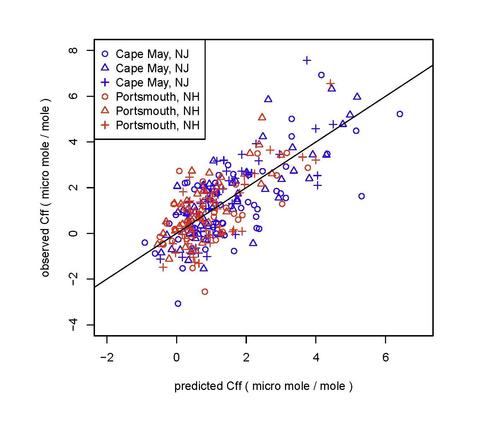Summary
Develop a proxy model to predict enhancement of C in atmospheric CO2 due to fossil fuel emissions (Cff) based on inexpensive measurements of anthropogenic trace gases. If successful, apply to NOAA tower network and aircraft measurements.
Description
DESCRIPTION:
Since fossil fuels are devoid of 14C, the measured 14C ratio of atmospheric CO2 (expressed as Delta-C) is the gold standard measurement to determine the fossil fuel enhancement, Cff, to any atmospheric CO2 measurement. With enough Delta-C measurements, independent, "top-down", estimation of US fossil fuel CO2 emissions should be possible. However, the number of such measurements is severely constrained by cost, accessibility to accelerator mass spectrometers and the volume of air required for a sufficiently high precision measurement. Thus, Delta-C is currently measured in only a small subset of NOAA/ESRL Global Monitoring Division (GMD) tall-tower and aircraft air samples. We predict Cff as a function of inexpensive and more frequently measured anthropogenic traces gases with a Projection Pursuit Regression (PPR) model. The surrogates gases include CO, SF6, and halo- and hydro-carbons. These gases were measured at various altitudes near Cape May, NJ,and Portsmouth, NH, with airplane-based instruments from 2005 to 2011. In our study, we fit one PPR model to observations from both of these sites.
In the PPR model, the multivariate surrogate gases data vector is projected along particular direction vectors. Each direction vector is determined when fitting the PPR model to the data. The projection along each direction vector is smoothed. The form of the smoother is adjustable.We select the complexity and form of the Projection Pursuit Regression model with a statistical learning method called cross-validation. For each particular from of the PPR model, we fit the model to training data. We select the optimal model by minimizing the mean-square difference between observed and validation data. After selecting the model by this cross-validation procedure, we then predict Cff values for test data excluded from the modeling building process.

Major Accomplishments
- The performance of the PPR depends critically on which surrogate gases are included in the model and the complexity and form of the PPR model. We focused on a PPR model where the smoothing functions are regression splines with adjustable degrees-of-freedom. We jointly determined which gases to include in the model and the effective degrees-of-freedom of the smoothing splines by cross-validation.
- The root-mean-square difference between predicted and observed Cff for the test data is approximately 1.1 µmole/mole. Since the uncertainties of Cff measurements due to random and systematic sources are approximately 1 µmole/mole and 0.5 µmole/mole, the PPR proxy model is a promising candidate to predict Cff,and expand the number of Cff measurements throughout North America by a factor of 3 to 4.
- Based on knowledge of the random uncertainty and systematic uncertainty of Cff measurements, we determined that the difference between the surrogate model prediction for Cff and observed Cff were not statistically significant. In the deviation (observed - predicted) time series, there may be some interesting structures. Some structures may arise since systematic errors may vary temporally and spatially. This topic is currently under study.
- We studied alternative models including: a multivariate linear regression proxy model,a one-dimensional linear surrogate model, and a Multivariate Adaptive Regression Spline (MARS). According to cross-validation, the PPR model was superior to each of these alternative model.
- Kevin Coakley, John Miller, Scott Lehman, Steven Montzka, Arlyn Andrews, and Ben Miller, "Creating a mulit-gas proxy for Delta-14 atmospheric fossil fuel-CO2," presentation at the 2013 Fall Meeting of the American Geophysical Union.
- A draft manuscript to be submitted to a peer-reviewed journal is undergoing NIST review.

